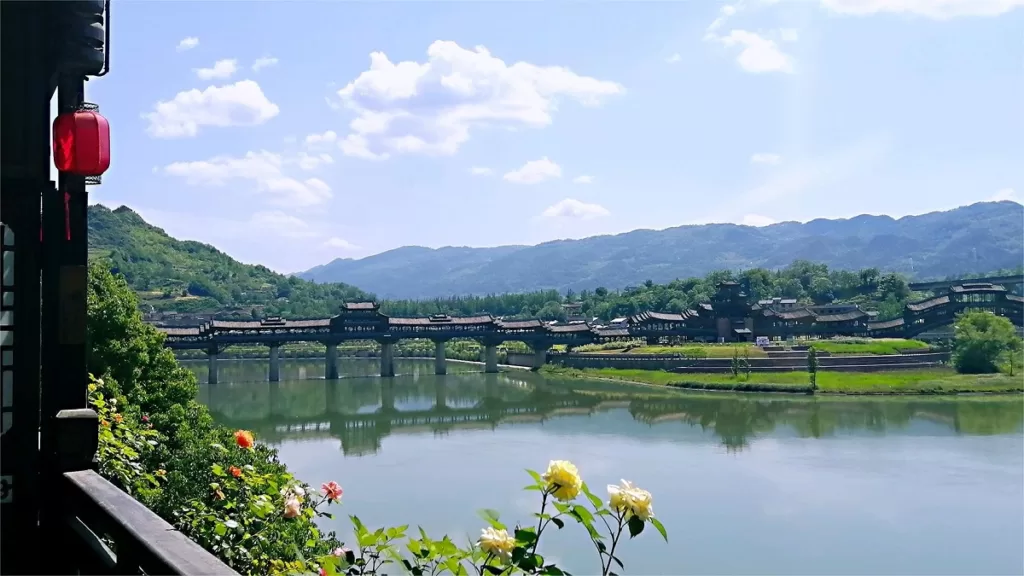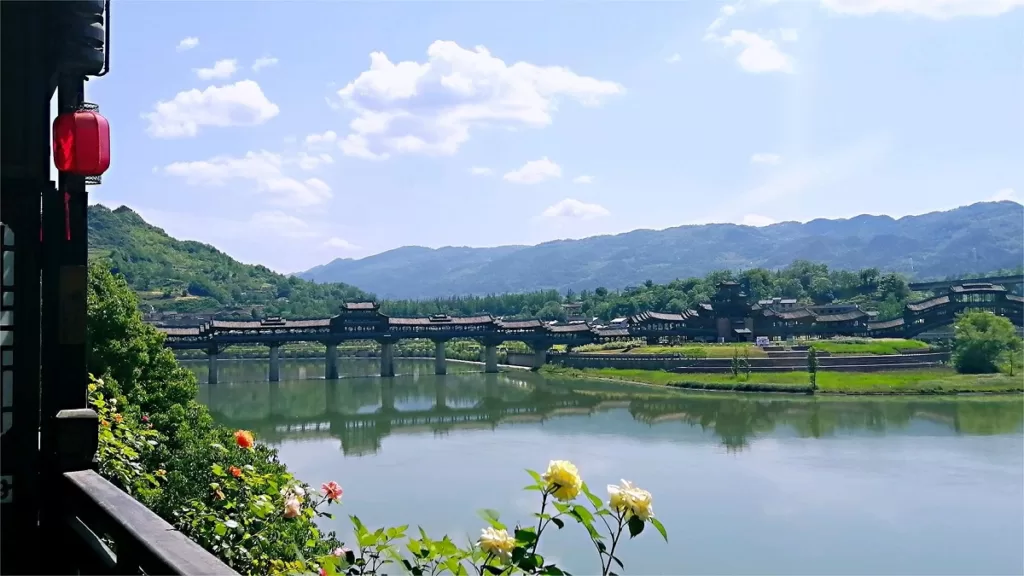Zhuoshui Ancient Town, Chongqing – Ticket Price, Opening Hours, Transportation, and Highlights


Nestled within the boundaries of Zhushui Town in the Qianjiang District of Chongqing, China, lies the enchanting Zhushui Ancient Town (濯水古镇). With its roots tracing back to the Tang Dynasty, its heyday during the Song Dynasty, and gradual decline in the later Ming and Qing dynasties, Zhushui Ancient Town is one of the renowned ancient towns in the southeastern part of Chongqing.
As a quintessential example of the old streets within Chongqing, Zhushui Ancient Town has preserved its historical charm and a rich cultural blend, where you can witness the fusion, inheritance, and innovation of Ba culture, Tujia culture, and Han culture. Furthermore, it serves as a canvas for the interwoven narratives of dock culture, merchant culture, and market town culture.
Table of Contents
- Basic Information
- Location and Transportation
- Highlights of Zhuoshui Ancient Town
- Vlog about Zhuoshui Ancient Town
- Useful Tips Summarized from Reviews
- Other Attractions in Qianjiang District
Basic Information
| Estimated Length of Tour | Half a day |
| Ticket Price | Free |
| Opening Hours | 24 hours a day throughout the year |
| Telephone Number | 0086-023-79468666 |
Location and Transportation
Zhushui Ancient Town is nestled in the southeastern corner of Zhushui Town in the southern part of the Qianjiang District, Chongqing, China. It is strategically located along the banks of the Apon River, one of the principal tributaries of the Wujiang River. Situated just 26 kilometers to the south of the center of Qianjiang and 21 kilometers to the north of Apon River Town, it enjoys close proximity to the Zhoubai Airport, a mere 26 kilometers away.
To reach Zhushui Ancient Town from Chongqing, follow these steps:
- Depart from Chongqing North Railway Station: Begin your journey by heading to Chongqing North Railway Station. There, you can catch a high-speed train to your destination.
- Take the High-Speed Train to Qianjiang Station: At Chongqing North Railway Station, look for high-speed trains bound for Qianjiang Station. These trains run daily, with departures at approximately 9:20 AM and 4:59 PM. The journey takes around 3 hours, and ticket prices are roughly 80 RMB.
- Taxi to Zhushui Ancient Town: Once you arrive at Qianjiang Station, you can take a taxi from Qianjiang Station. The taxi ride should take about 20 kilometers and cost around 50 RMB, taking you directly to the charming ancient town.
Highlights of Zhuoshui Ancient Town
Ancient Streets

The ancient streets of Zhushui Ancient Town are paved with smooth, grey flagstones and stretch for a thousand meters, with a width varying from 2 to 3.5 meters. Along these historic streets, you’ll find a collection of wooden structures housing businesses, residences, guild halls, and schools. These architectural wonders include houses on stilts, traditional Chinese courtyards, and distinctive local features like the cuoji kou, a corner of the roof turned up in an elegant curve. Within these residences, you’ll also discover beautifully painted murals adorning the walls, wooden window carvings, and exquisite stone carvings on the doorstep, a harmonious fusion of Tujia stilted houses and Hui-style buildings.
At the entrance to the ancient town, you’ll encounter the Visitor Reception Center, a historical ancient opera stage with over 300 years of history. The detailed carvings of characters on the eaves are well-preserved, offering a glimpse into the town’s rich heritage.
Tujia Stilted Houses

The most intact structures in Zhushui Ancient Town are the colossal Tujia stilted houses situated along the river. These houses are built on the river embankment of the Apon River, which stands four to five meters high, crafted from stone and having a history of over two centuries, yet they remain remarkably well-preserved.
Moral Integrity Stele

The Moral Integrity Stele, located in the middle of the ancient street, stands at a height of 1 meter and is 50 centimeters wide. Erected in 1888 during the 14th year of the Guangxu reign in the Qing Dynasty, the Moral Integrity Stele has a history of over a century. The stele bears the incised words “天理良心,” which translates to “Heavenly Principles and Good Conscience.” It serves as a reminder to the merchants of the ancient town to conduct business, act, and live according to these principles, adhering to both ethical and moral standards.
Fengyu Bridge (Wind and Rain Bridge)

Spanning the Apon River, the Fengyu Bridge, or Wind and Rain Covered Bridge, is a 658-meter-long structure divided into four distinct sections, each showcasing unique architectural elements and built in different time periods. The first section, “Zhuohe Huaiyuan (濯河怀远),” stretches for 310 meters and features a multi-story pavilion with a central tower at its highest point. The bridge’s design combines various architectural techniques, including double eaves, hipped roofs, Tujia watchtowers, and intricate eave carvings, resulting in an elegantly rustic appearance.

The second section, “Tang Zhong Chang Yun (唐钟怀韵),” measures 105 meters in length and incorporates a 26-meter-high bell tower divided into four stories. The central tower and the surrounding walkway create a unique visual appeal, with the towering bell tower housing a replica of an ancient Tang Dynasty bronze bell.The third section, “Caihong Fubo (彩虹伏波),” spans 97 meters over the Puhua River. This single-arch bridge combines curvilinear and straight-line elements, creating a graceful, rainbow-like structure.The fourth section, “Puhua Feilong (蒲花飞龙),” extends for 146 meters and features a fusion of curved roofs and modern lattice piers. The façade is inspired by the overall form of a dragon.
Baxian Hall (Eight Virtues Hall)

Also known as the Yu Family Mansion, the Baxian Hall was originally built in 1751 during the 16th year of the Qianlong reign in the Qing Dynasty. Covering an area of 800 square meters, it’s the second-largest historic residence in the town, after the Guangshun Mansion. This three-courtyard structure is made of wood and brick, with gabled walls on both sides, small grey bricks in the horsehead walls, and bluestone strips at the corners and courtyards. Adorned with decorative animal heads, these structures are meant to ward off evil spirits and bring good fortune. The Baxian Hall is an elegant and stately building, primarily featuring shades of grey, white, and natural wood colors.
Wantian Temple

Also known as the Jiang-Zhe Guild Hall, the Wantian Temple was established during the Qing Dynasty’s Qianlong era. At the time, it was built by merchants from the Jiangsu and Zhejiang provinces who came to trade in Zhushui Ancient Town. The complex includes a grand hall, Wantian Pavilion, a central hall, a meeting hall, a decorative screen, a red pool, a main gate, galleries, side gates, and various other structures. The entire complex exudes the distinctive charm of a southeastern Chinese ancient town. The Wantian Temple is one of the town’s three major guild halls and serves as an iconic architectural symbol of Zhushui Ancient Town.
Vlog about Zhuoshui Ancient Town
Useful Tips Summarized from Reviews
Try Special Local Snacks: A must-try snack in Zhuoshui Ancient Town is “Yeerba,” which comes in two flavors: one with white sesame and peanut taste, and the other with tofu, pickled vegetables, cured meat, and beans. These snacks are distinctive to the region and offer a unique culinary experience.
Photography at the Covered Bridge: After dinner, head to the covered bridge in the town to take some photos. The bridge looks even more beautiful when illuminated at night, providing excellent opportunities for photography.
Transportation Tips: If traveling from Chongqing to Qianjiang, a normal train ticket costs around 41.5 yuan and takes over three hours. From Qianjiang Railway Station, you can take a taxi to Zhuoshui Ancient Town for approximately 60 yuan. Alternatively, you can take a bus for 9 yuan. Consider these options when planning your journey to and from the ancient town.
Evening Entertainment: In the evening, Zhuoshui Ancient Town hosts bonfire parties where visitors can gather, dance, and enjoy themselves. It’s a lively and joyful atmosphere that adds to the overall experience of the town. Don’t miss the chance to participate and immerse yourself in the local culture and festivities.
Other Attractions in Qianjiang District

Qianjiang City Grand Canyon

Xiaonanhai National Geological Park

Chongqing Ethnic Museum
Attractions in Chongqing suburbs, Attractions in Qianjiang District Chongqing, Chongqing historical sites